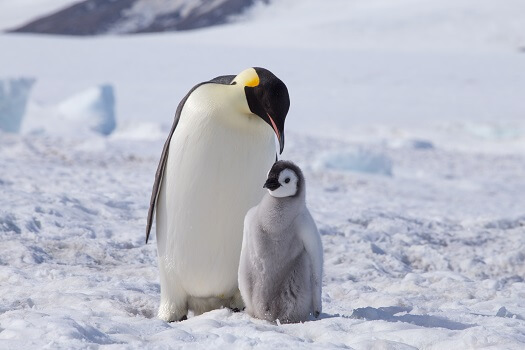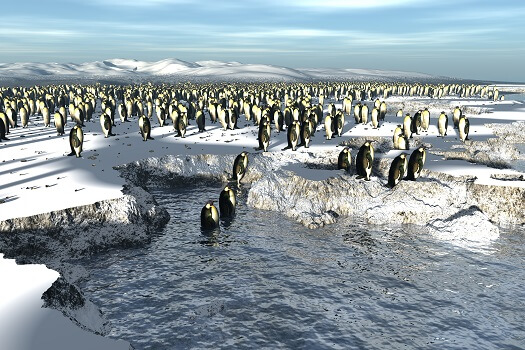
Penguins are a group of flightless birds that are almost exclusively found south of the equator. Only one species, the Galapagos penguin, is found in the northern hemisphere. Penguins are aquatic birds and are highly adapted for life in the water, where they spend approximately half their lives. When most people think of penguins, they think of cold, snowy climates but not all species of penguins are found in the Antarctic. Some are spread out throughout the southern hemisphere, including countries like New Zealand, Australia, Chile, Peru, and even southern Africa! The Galapagos penguin is found in warm climates near the equator. Penguins vary greatly in size and the larger penguins are more likely to be found in colder climates. The largest penguin is the emperor penguin which can reach approximately 3.6 feet (1.1 meters) in height and weigh between 59.5 and 90 lbs (27 and 41 kilograms). In contrast, the smallest penguin, the little blue or the fairy penguin, is 10 – 12 inches (25 – 30 cm)in height, and its average weight is 2.2 lbs (1 kilogram). Although penguins can not fly, they are excellent swimmers! Their wings act like strong flippers, helping them to move quickly through the water. Penguins swim to depths of 20 meters searching for food, although some species have been recorded as swimming as deep as 30 meters! These birds can hold their breath for an average of two to three minutes underwater which helps them when they are hunting. Penguins usually reach sexual maturity between three and eight years of age. The breeding season usually occurs in the spring and summer months, when the male establishes a nest site and tries to attract a female. Most penguins are monogamous for the mating season. Some species, like the emperor penguins, form colonies to nest while others dig burrows or make nests in caves or under rocks. Penguins often produce two eggs, except for the emperor and king penguins who produce only one. Both the male and female spend time incubating the egg, while the other parent goes off to search for food. Over half of the world’s penguins are threatened with extinction. Five penguin species are listed as endangered by the IUCN’s Red List; the yellow-eyed penguin, the erect-crested penguin, the Northern rockhopper penguin, the African penguin, and the Galapagos penguin. Five further species are listed as vulnerable. The biggest threats to penguin populations include climate change, overfishing, the destruction of their habitat, and invasive diseases. There are 18 species of penguins in total. These range from the small blue penguin found in New Zealand, to the mighty emperor that lives in the cold and snowy climate of the Antarctic. Let’s take a look at some of them. Emperor Penguin (Aptenodytes forsteri) – the largest of the penguin species, this large bird can be over a meter in height. They live in colonies on the Antarctic ice, where they keep each other warm from the wind chills which can reach -76 degrees Fahrenheit. Emperor penguins huddle together and take turns moving to the group’s interior to warm up. Once the penguin has warmed up it will move to the outer edge of the group to let another penguin escape from the cold wind! Macaroni Penguin (Eudyptes chrysolophus) – also found in the Antarctic and surrounding islands, macaroni penguins are crested penguins and have an orange crest that flows back from the center of their forehead. Macaroni penguins are the most numerous of all penguin species and it is estimated that there are 18 million of these penguins in the wild today! African Penguin (Spheniscus demersus) – these penguins are found in large colonies along the rocky coast of southern Africa. The largest colony is found on Dyer Island. To cope with the hotter weather found in southern Africa, these penguins have a small pink gland above each eye. When the penguins get hot, blood is sent to this gland where it is cooled by the surrounding air. The hotter the penguins get, the more blood is sent here and the pinker the gland becomes. Blue Penguin (Eudyptula minor) – also known as the little penguin, the fairy penguin, or the little blue penguin, this is the smallest of the penguin species and gets its name from the slate-blue and indigo feathers that are found on top of its body. Adults average between 10 – 12 inches (25 – 30 cm) in height and weigh just 2.2 – 3.3 lbs (1 – 1.5 kg). These penguins are found in the coastal areas of Australia and New Zealand. Galapagos Penguin (Spheniscus mendiculus) – this penguin is endemic to the Galapagos Islands and is the only penguin found north of the equator. These penguins are listed as endangered and it is estimated that there are just 2000 left. The main threats to these animals include pollution, climate change, and getting caught as bycatch in fishing nets. Humboldt Penguin (Spheniscus humboldti) – this medium-sized penguin is found on islands and rocky coastal areas of Chile and Peru in the southeastern Pacific Ocean. Research has shown that these penguins travel long distances between their breeding and feeding grounds. Humboldt penguins are burrowing penguins and build their nest sites in guano (fecal) deposits. Penguins are flightless, aquatic birds that are mostly found in the southern hemisphere. These birds are great swimmers and spend a lot of their lives swimming and feeding in the ocean waters. They have some amazing biological adaptations that help them to live their life in the water. Let’s take a closer look at some of them! One amazing adaptation that penguins have is the oil gland, also called the preen gland. This gland produces waterproofing oil that the penguins can spread over their feathers. Not only does this oil help penguins to insulate their body from the cold water, but it also helps to reduce friction, allowing them to glide through the water. The scientific name for this gland is the uropygial gland and it is most developed in birds that live on the water because it aids in waterproofing the feathers. Unlike most birds that shed a few feathers at a time, penguins go through a full molt and lose all their feathers at once in a process called catastrophic molt! As penguins are not waterproof when they lose their feathers, they condense their molting period into a short time for which they must stay on land, and finish the process as soon as possible. Molting is a three-stage process. For most penguin species, this molt occurs after breeding. In the first stage of molting – which occurs after the chicks leave – the penguin goes to sea to feed for a few weeks and put on some pounds before returning to land to molt. During this time the penguin’s body is already making the new feathers. Once the penguin returns to land, stage two can begin and the bird begins to lose and replace its feathers. As a penguin is not waterproof during this time, it stays on land and so must go hungry for several weeks! In the final stage, the bird can return to sea and feed to replenish the weight that it lost over this time. Penguins have very hard and thick bones, unlike other birds that have a light skeleton to help them fly. A penguin’s skeleton is heavier than other birds because the bones are not filled with air. This heavier skeleton acts like a divers weight belt, helping them to submerge quickly underwater when they dive. A penguin’s skeleton also differs in other ways. For example, their wings have much shorter bones than the wings of other birds, and some of these bones are fused. Their robust skeleton also helps them to be powerful swimmers, providing them with stiffer fins which they use to maneuver through the water more efficiently.
Kingdom
Animalia
Phylum
Chordata
Class
Aves
Order
Sphenisciformes
Family
Spheniscidae
Genus
6
Species
18
Height
15 inches – 3.5 feet (38.1 cm -106.7 cm)
Weight
2 – 80 pounds (0.9 – 36 kg)
Lifespan
2 years
Status
Various
Preferred Habitat
Oceans, coastal areas
Average Clutch size
2
Main food item
Krill, fish, crustaceans, and squid
Main predators
Sharks, killer whales, and leopard seals.
The Basics

Types of Penguin

Fun Facts about Penguins!
Waterproofing Gland
Yearly Moult

Dense Bones
